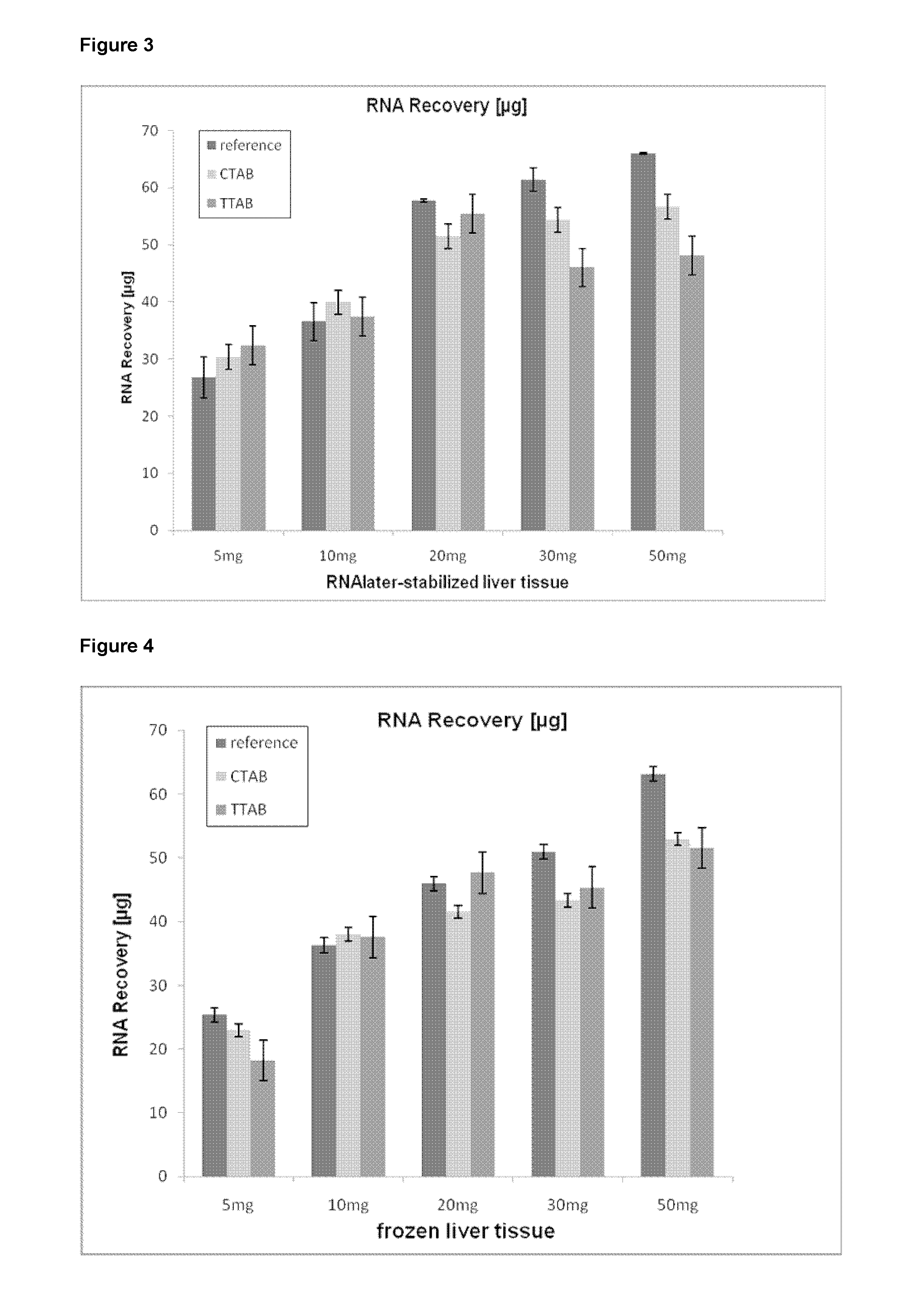Method of isolating purified RNA with reduced DNA contaminations
- Summary
- Abstract
- Description
- Claims
- Application Information
AI Technical Summary
Benefits of technology
Problems solved by technology
Method used
Image
Examples
example 1
[0088]Effect of different detergents on the elimination of genomic DNA during isolation of RNA from rat liver was assessed by the following method:[0089]1. 270 mg of RNAlater-stabilized liver tissue were homogenized in 27 ml of Qiazol reagent, an acidic phenol and chaotropic salt-containing reagent, using a TissueRuptor homogenizer.[0090]2. 1000 μl of the resulting homogenate was aliquoted into 2 ml Eppendorf tubes. Thus, 10 mg of tissue was used per sample.[0091]3. 8 μl (5 μg) of genomic DNA was added to the Qiazol reagent prior to phase separation.[0092]4. In a next step, 100 μl of the following detergents were added to the homogenates (in duplicate):[0093]Triton X-100 [100%][0094]Tween20 [20%][0095]Cetyl-trimethyl-ammonium bromide [1%], CTAB[0096]Tetra-decyl-trimethyl-ammonium bromide [1%], TTAB. For the reference, no detergent was added (“reference”). This was followed by the addition of 200 μl chloroform and vortexing.[0097]5. The samples were centrifuged for 15 min at 12.000×g...
example 2
[0113]The following experiment was done to assess the amount of genomic DNA co-purified during RNA isolation from different tissues using the Qiazol reagent while adding the detergent directly to the homogenate:[0114]1. 200 mg of RNAlater-stabilized lung, kidney, heart, spleen and brain tissue were homogenized in 8 ml Qiazol reagent, using a TissueRuptor homogenizer.[0115]2. Homogenates, 1000 μl each (corresponding to 25 mg tissue per sample), were aliquoted into 2 ml Eppendorf tubes and 100 μl of the following detergent stock solutions were added thereto:[0116]Cetyl-trimethylammonium bromide [1%], CTAB[0117]Tetra-decyltrimethylammonium bromide [1%], TTAB. For the reference, no detergent was added (“reference”). This was followed by the addition of 200 μl chloroform and vortexing.[0118]3. The samples were centrifuged for 15 min at 12.000×g at 4° C. and the resulting aqueous phase was transferred into new Eppendorf tubes.[0119]4. The supernatant was mixed with 1.5 volumes of absolute...
example 3
[0131]RNA was isolated from increasing amounts of tissue using the Qiazol reagent wherein the cationic detergent was directly added to the homogenate according to the following procedure:[0132]1. 5 mg, 10 mg, 20 mg, 30 mg and 50 mg of (a) RNAlater-stabilized liver or (b) frozen liver were homogenized in 1 ml Qiazol reagent using a TissueRuptor homogenizer.[0133]2. 100 μl of the following detergent stock solutions were added:[0134]Cetyl-trimethylammonium bromide [1%], CTAB[0135]Tetra-decyltrimethylammonium bromide [1%], TTAB. For the reference, no detergent was added (“reference”). This was followed by the addition of 200 μl chloroform and vortexing.[0136]3. The samples were centrifuged for 15 min at 12.000×g at 4° C., the resulting aqueous phase was transferred into new Eppendorf tubes.[0137]4. The supernatant was mixed with 1.5 volumes of absolute ethanol and the aqueous phase was transferred onto RNeasy mini columns (Qiagen) and centrifuged for 15 s at 8.200×g, followed by a wash ...
PUM
| Property | Measurement | Unit |
|---|---|---|
| Fraction | aaaaa | aaaaa |
| Fraction | aaaaa | aaaaa |
| Fraction | aaaaa | aaaaa |
Abstract
Description
Claims
Application Information
 Login to View More
Login to View More - R&D
- Intellectual Property
- Life Sciences
- Materials
- Tech Scout
- Unparalleled Data Quality
- Higher Quality Content
- 60% Fewer Hallucinations
Browse by: Latest US Patents, China's latest patents, Technical Efficacy Thesaurus, Application Domain, Technology Topic, Popular Technical Reports.
© 2025 PatSnap. All rights reserved.Legal|Privacy policy|Modern Slavery Act Transparency Statement|Sitemap|About US| Contact US: help@patsnap.com



